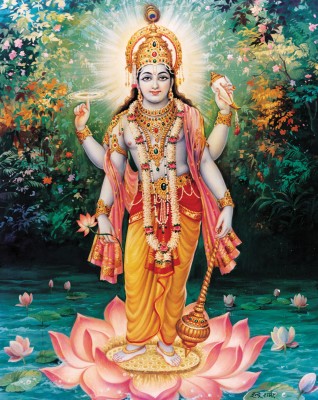The four arms indicate Lord's omnipresence and omnipotence. The two front arms signify the lord's activity in the physical world and the two back arms signify His activity in the spiritual world. The right side of the body represents the creative activities of the mind and the intellect. The left side symbolizes the activities of the heart; that is, love, kindness, and compassion.
A conch in the upper left hand indicates that the Lord communicates with His devotees with love and understanding. When blowing His conch, He reminds his devotes to live in this world with kindness and compassion towards all living beings. A chakra in His upper right hand conveys the idea that the Lord uses this weapon to protect His devotees from evil. The mace denotes energy and a mace in the Lord's left lower hand signifies that He sustains the manifest world by the energy that He holds in Himself. His front right hand is depicted bestowing grace on His devotees.
The snake denotes the mind and the thousand heads of the snake signify innumerable desires and passions of an individual. Just as a snake destroys its victim by its venom, an uncontrolled mind destroys the world by the venom of its possessiveness. The Lord has controlled all desires, and this is symbolized by showing Him seated on the two coils of the snake. When a sincere devotee of the Lord controls his desires, the Lord fulfills the devotee's genuine desires and helps him on his path.
The blue sky in the background of the Lord suggests that He pervades the entire universe. The blue color symbolizes infinity. The blue body of the Lord signifies that He has infinite attributes. He is nameless, formless, and immeasurable. The color yellow is associated with earthly existence and the yellow clothes of the Lord signify that He incarnates Himself on this earth to uphold righteousness and destroy evil and unrighteousness.
A flower garland around the Lord's neck is a symbol of the devotee's adoration for the Lord. A gem decorating His neck signifies that the Lord fulfills all genuine desires of His devotees and provides for their needs. The crown is a symbol of the Lord's supreme power and authority. The two earrings signify the dual nature of creation, such as knowledge and ignorance, happiness and unhappiness, and pleasure and pain.
The worship of Lord Vishnu is very popular among Hindus, especially among the followers of the Vaishnava tradition (Vaishnavism). He is the second member of the Hindu Trinity, with Lord Brahma and Lord Shiva as the other two. Lord Vishnu is also known by other names, such as Vasudeva and Narayana. The following ten incarnations of Lord Vishnu are described in Hindu mythology and are popular among Hindus. These incarnations reveal the help rendered by God during various stages of human evolution. As shown below, the first two incarnations are in the animal form, the third one is half-human and half-animal, and the fourth and the subsequent ones are all in human form. These incarnations relate to human evolution from aquatic life to human life, and are consistent with the modern theory of evolution suggested by science:
- Matsya (fish)---saves Sage Manu from floods and recovers the Vedas from demons.
- Kurma (tortoise)---sustains the earth on his back.
- Varaha (boar)---brings the earth back from the bottom of the ocean where it was dragged down by a demon, known as Hiranyaksha; Varaha kills the demon.
- Narasimha (man-lion)---kills the demon King Hiranyakashipu, who was planning to kill his own son, a devotee of Lord Vishnu.
- Vamana (dwarf)---the first human incarnation of the Lord, kills the demon King Mahabhali, who had deprived the gods of their possessions.
- Parasurama (the warrior with an axe)---saves Brahmins from the tyranny of the arrogant Kshatriyas.
- Rama---kills Ravana, the demon king of Lanka.
- Sri Krishna---the most popular incarnation; Krishna's contributions throughout his life include the teachings of the Bhagavad Gita to Arjuna.
- Buddha---Hindus consider Buddha as an incarnation of Lord Vishnu and accept his teachings, but do not directly worship him.
- Kalkin (a man on a white horse)---this incarnation is yet to come and will mark the end of all evil in the world.



